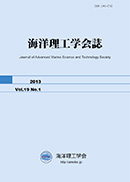26 巻, 1 号
選択された号の論文の5件中1~5を表示しています
- |<
- <
- 1
- >
- >|
原著
-
2020 年 26 巻 1 号 p. 1-9
発行日: 2020/12/31
公開日: 2020/12/25
PDF形式でダウンロード (2685K) -
2020 年 26 巻 1 号 p. 11-23
発行日: 2020/12/31
公開日: 2020/12/25
PDF形式でダウンロード (2978K) -
2020 年 26 巻 1 号 p. 25-34
発行日: 2020/12/31
公開日: 2020/12/25
PDF形式でダウンロード (1370K) -
2020 年 26 巻 1 号 p. 35-47
発行日: 2020/12/31
公開日: 2020/12/25
PDF形式でダウンロード (7716K)
話題提供
-
2020 年 26 巻 1 号 p. 49-51
発行日: 2020/12/31
公開日: 2021/02/06
PDF形式でダウンロード (1731K)
- |<
- <
- 1
- >
- >|
